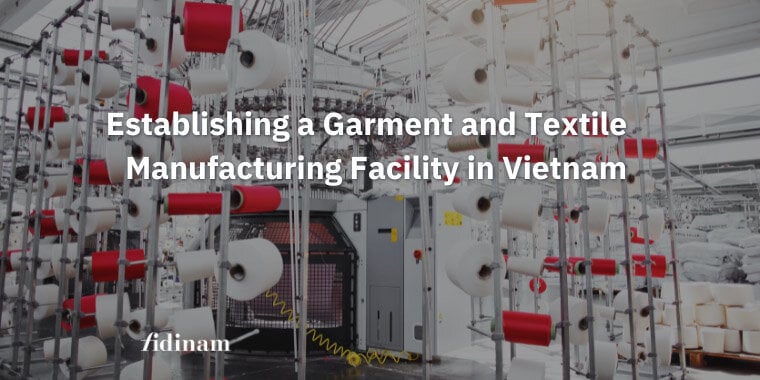
As the global fashion industry evolves, Vietnam has become a top choice for garment manufacturing, thanks to its robust infrastructure, skilled workforce, cost advantages, and favorable trade agreements. This article explores the administrative procedures and benefits of setting up a garment and textile production factory in Vietnam.
Vietnam allows foreign investors to incorporate 100% foreign-owned companies in garment and textile production.
To set up a foreign-owned company (i.e. 100% foreign-owned company or joint-venture company) (“Vietnam Company”), the investors need to conduct the following steps:
The term of an IRC can be up to 50 years.
There is no term for the ERC.
The company is legally established on the date of the ERC.
The VN Co shall have at least one and may have more Legal Representative(s). One of them must be a resident of Vietnam.
In case the VN Co has only one legal representative, during the time the only Legal Representative does not stay in Vietnam, they are required to grant an Authorization Letter to a person in Vietnam to take over their duties under their instruction and strictly comply with the law.
In short: if the only legal representative is not a Vietnam resident, a legally authorized representative in Vietnam is required.
The Capital Structure of the VN Co which needs to be registered in the application and eventually mentioned in the IRC, includes the Charter Capital and the Long-term Loan Capital.
Charter Capital is the capital that the Investors shall pay fully to the Capital Account opened at a licensed bank in Vietnam within 90 days as of the date of issuance of the ERC.
Long-term Loans are those having a duration of more than 1 year and are optional. If the Investors have plans to grant a Long-term Loan to the VN Co, it is required to include the Long Term Loan in the company incorporation application. Otherwise, no Long-term Loan is included.
During the production process, the projects of textile and garment production must comply with regulations on waste collection and treatment, wastewater treatment, and environmental protection measures.
Besides,
According to the provisions of Circular 21/2017/TT-BCT (amended by Circular 07/2018/TT-BCT) promulgating national technical regulations QCVN 01:2017/BCT the content limits of formaldehyde and aromatic amines derived from azo colorants in textile and garment products as follows:
Textile and garment products must be registered, conform to these limits, and bear conformity marks before being traded in the Vietnamese market.It is required to be registered with a declaration of conformity and affix conformity marks according to current regulations and regulations in QCVN 01:2017/BCT.
The Vietnamese government offers numerous investment-related business incentives to retain the country’s appeal to international investors, and it continually enhances its offerings through reforms and upgrades.
There are 4 forms of incentives that are available to investment projects within Vietnam as follows:
The above incentive applied for the investment project is based on the fields of business, location, investment zone, project scale, and other factors of investment projects.
Investing in production projects, especially in garment and textile manufacturing, is particularly appealing in areas eligible for investment incentives, such as Industrial Parks, Export-Processing Zones, Hi-Tech Parks, and Economic Zones.
Additionally, projects in manufacturing of the following textile & garment industry products with priority for development are entitled to enjoy the CIT incentives:
The enterprises doing garment and textile production from the implementation of the new investment projects in Hi-Tech Parks and Economic Zones, and the new investment projects manufacturing of the following textile & garment industry products with priority for development shall enjoy the incentive of:
The enterprises doing garment and textile production from the implementation of the new investment projects in Industrial Parks, Export-Processing Zones shall enjoy the incentive of exemption for 2 years, and a reduction of 50% of tax payable for a maximum period of 4 subsequent years calculated from the first year having taxable income from the investment project.
Some of the largest markets of the textile & garment industry products of Vietnam are USA, EU, China, Korea, and Japan. Following the relevant FTAs, the textile & garment industry products exported from Vietnam can enjoy the benefit of reduction or elimination of customs duties.
The Vietnam - EU Free Trade Agreement (EVFTA) that officially took effect on 1 August 2020 has opened up opportunities for large reduction or elimination of customs duties for many industries in Vietnam, including the textile & garment industry.
The EU has eliminated import taxes since the effective date of EVFTA for the textile and garment raw materials belonging to Chapters 50-60 of the Tariff Schedule of the Union, and some types of garment product groups in Chapters 61-65 of the Tariff Schedule of the Union (such as suits, swimwear, blankets, curtains, ...).
The remaining products will have import taxes gradually eliminated to 0% within 4 - 8 years from the effective date of EVFTA.
However, to enjoy preferential tariffs, and customs duty from the EVFTA, Vietnamese textiles and garments must meet the regulations on rules of origin under this Agreement and be issued a Certificate of Origin (C/O) form. EUR.1 according to EVFTA.
For the Asian region, following the ASEAN-China Free Trade Area (ACFTA) between the Member States of the Association of Southeast Asian Nations (ASEAN, comprising Brunei, Cambodia, Indonesia, Lao, Malaysia, Myanmar, Philippines, Singapore, Thailand, and Vietnam) and China, China committed on the reduction or elimination of customs duties for textile & garment products imported from Vietnam.
From 2018, import taxes for almost all the textile and garment products exported from Vietnam to China have been eliminated to 0%.
With Vietnam’s strategic trade agreements, robust infrastructure, and skilled workforce, the country provides an optimal environment for global brands seeking to enhance their production capabilities and expand their reach.
To explore how you can benefit from this opportunity and successfully set up your garment and textile production in Vietnam, contact Fidinam Vietnam today for comprehensive support and guidance throughout the process.
All content © . All Rights Reserved.